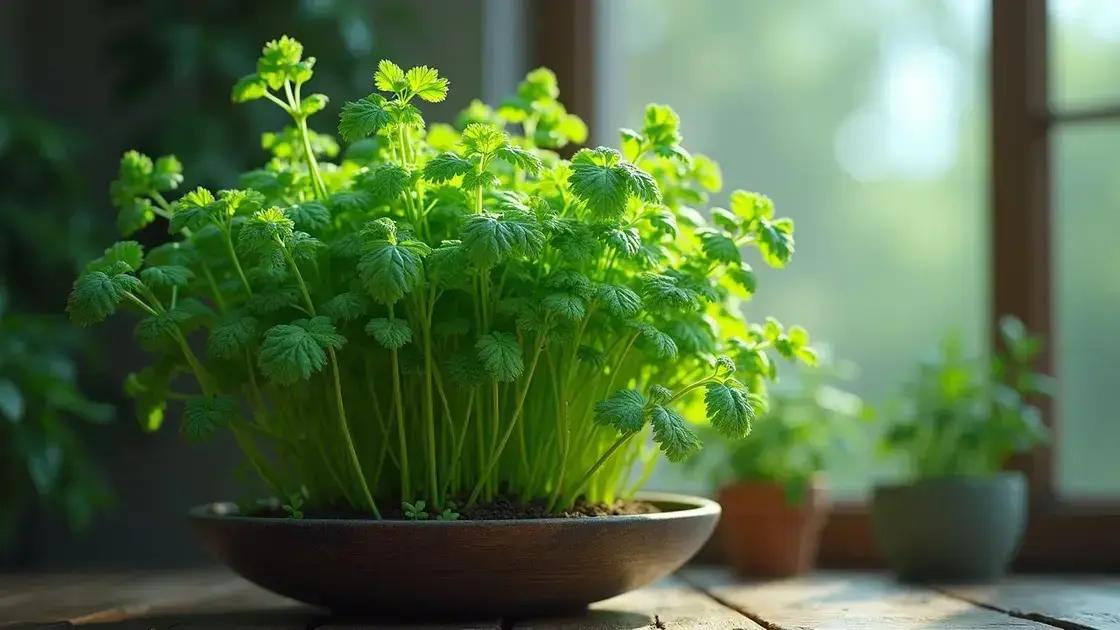How to Care for Cilantro Plant Indoors: 7 Essential Tips for Success
How to care for cilantro plant indoors can be a rewarding experience for indoor gardening enthusiasts. Whether you’re a beginner or someone looking to enhance your green thumb, understanding how to nurture these fragrant herbs is crucial. You will discover effective methods for creating the ideal environment for cilantro, including tips on water, light, and pest management.
Table of Contents
ToggleEssential tips for growing cilantro indoors
How to care for cilantro plant indoors is essential for anyone looking to grow this fragrant herb successfully. With the right strategies, you can ensure your cilantro thrives in an indoor setting and provides fresh flavors for your dishes.
Understanding cilantro’s needs
- Soil: Use well-draining potting mix rich in organic matter.
- Watering: Keep the soil moist but not soggy. Water cilantro plants when the top inch of soil feels dry.
- Light: Cilantro prefers 6-8 hours of bright, indirect sunlight daily.
Optimal conditions for healthy growth
- Choose a suitable pot that allows for drainage. A container with a depth of at least 6 inches is ideal.
- Maintain a temperature range of 60-75°F (15-24°C) for best results.
- Fertilize monthly with a balanced liquid fertilizer during the growing season.
Common issues and solutions
When growing cilantro indoors, be aware of potential problems:
- Leggy growth: If your cilantro becomes tall and spindly, it may not be getting enough light. Move it closer to a window or use grow lights.
- Pest management: Watch for aphids or spider mites; insecticidal soap or neem oil can help manage pests effectively.
- Bolting: Cilantro can bolt if it gets too warm. Keep the plant in a cooler spot and provide enough light.
For more tips on exploring indoor gardening techniques, consider joining a community of indoor gardeners and sharing your experiences.
Conclusion
Caring for cilantro indoors requires attention to light, water, and soil conditions. Following these essential tips can have your cilantro flourishing in no time!
Optimal light and watering for cilantro plants

Optimal light and watering for cilantro plants are crucial for their healthy growth and vibrant flavor. Understanding these two elements can significantly enhance your indoor gardening experience.
Understanding light requirements
Cilantro thrives in bright, indirect sunlight. Here are some key points to remember:
- Provide 6-8 hours of light daily. If your indoor space lacks natural light, consider using grow lights.
- Rotate your cilantro plant regularly to ensure even light exposure on all sides.
- Avoid placing cilantro in direct sunlight for prolonged periods as this can lead to leaf burn.
Watering essentials for cilantro
Watering cilantro appropriately is just as important as providing the right light. Follow these best practices:
- Water the cilantro when the top inch of soil feels dry to the touch.
- Ensure your pot has drainage holes to prevent overwatering, which can lead to root rot.
- During warmer months, cilantro may require more frequent watering due to faster evaporation.
Signs of insufficient light and water
Being observant can help you adjust care before it’s too late:
- Yellowing leaves may indicate either overwatering or insufficient light.
- Leggy growth suggests your cilantro is reaching for more sunlight.
- Wilting leaves could indicate that the plant is underwatered.
For more insights into exploring indoor gardening techniques, seek out reputable sources and communities committed to herb care.
Common pests and their management in indoor cilantro gardens
Common pests and their management in indoor cilantro gardens are vital for maintaining healthy plants. Being proactive can prevent infestations and ensure your cilantro thrives.
Identifying common pests
Indoor cilantro plants are susceptible to several pests. Here are the most frequent offenders:
- Aphids: Small, soft-bodied insects that can cluster on leaves, sucking sap.
- Spider mites: Tiny arachnids that can cause damage by feeding on leaves, leading to stippling.
- Whiteflies: Small moth-like insects that fly off when the plant is disturbed and leave a sticky residue.
Effective pest management strategies
Managing pests effectively involves a combination of prevention and treatment:
- Regularly inspect the cilantro plants for signs of pests.
- Introduce beneficial insects like ladybugs that can help control pests naturally.
- Use insecticidal soap or neem oil as a treatment if an infestation occurs. Apply it in the early morning or late evening to avoid leaf burn.
- Ensure good air circulation around the plants to deter pests.
Preventing pest infestations
Taking preventive measures can significantly reduce the chances of pest problems:
- Keep the growing area clean to minimize potential hiding spots for pests.
- Avoid overcrowding plants, providing adequate space for growth and airflow.
- Rotate your crops to disrupt pest life cycles.
For further insights into exploring indoor gardening techniques, consider engaging with local gardening communities.
In conclusion
Caring for cilantro plants indoors involves understanding their needs for light, water, and pest management. By applying the essential tips discussed in this guide, you can create an ideal environment for your cilantro to flourish. Always remember to regularly monitor your plants for any signs of distress and adjust your care routine as needed. For additional tips on enhancing your indoor garden, consider exploring various resources available to indoor gardening enthusiasts.

